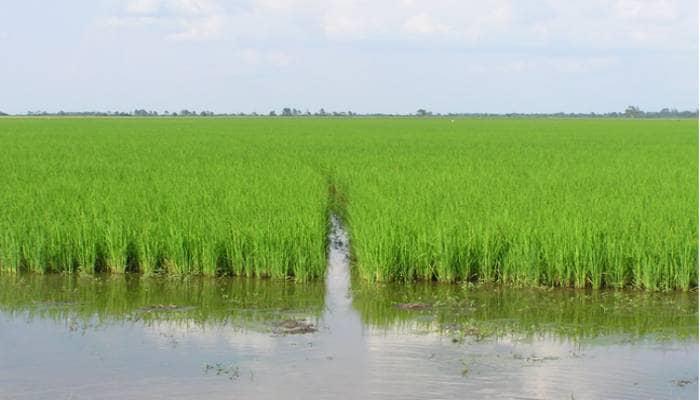Rice Cultivation In Sudan Experiences And Challenges
Khartoum, Jan.25 (Sudanow)-Rice is one of the ancient cereal grains in the world, and people have grown it for at least 5,000 years ago. It is a staple food for
more than half of the world's population, and 90% of the world's rice comes from Asia.
There are thousands types of rice, but depending on how producers process them, they fit into two groups: white or brown (whole grain).
White rice is the most common type, though brown rice offers more health benefits. Brown rice comes in a variety of shapes, including reddish, purplish, or black.
Manufacturers make many products from rice, including rice flour, rice syrup, rice bran oil, and rice milk.
Rice cultivation in Sudan is ancient, dating back to the 1950s in South Sudan. But the pioneering experience in which rice was cultivated in a scientific way and in which it was proven that rice can be grown in Sudan twice a year and with high productivity was in the experimental farm in Um Tikal, south of Duweim, with a grant from the Japanese government sponsored by the Japanese International Cooperation Agency (JICA).
Its aim was to establish the Abu Kasabah basin project, which is located on the western bank of the White Nile and extends from Shatawi to Kosti.
The study was conducted in Um Takal farm, which had an area of (360) hectares, on the methods of cultivating rice of all kinds, and on all rice samples that are grown globally. Samples of rice were selected that gave high productivity in Sudan. Sample (Indica) and Tos from (Japonica).
All agricultural operations were applied, from cultivation to hulling and whitening rice, with advanced mechanisms, except for the preparation of the land and cultivation by machine, seedling, or direct production. The productivity was high, as we produced 11 tons per hectare for some samples, and the lowest was in the secondary season 4 to 5 tons per hectare.
The experience was pioneering and successful by all accounts. The Abu Qasaba project did not establish intersections, in which politics has a role.
There are four types of rice were cultivated in Sudan, both submerged and aerial, with Egyptian varieties and Basmati rice..
The experiment was carried out by Al-Shatayeb Company, one of the companies of Sheikh Mustafa Al-Amin Group.
The expected productivity per feddan for different items is from 1.5 to 4 tons per feddan, according to the variety and according to the type of treatment that was conducted on it.
Knowing that, according to their reports, the best result so far is for cultivation that was carried out using organic fertilizers (compost)...
The cost of an acre from planting to harvesting is 500 thousand pounds, and the price of a ton of rice is (600) thousand pounds in the market.
Soba West Agricultural Project was established in 12/27/2022, a field day to harvest the rice crop as a unique experience in the state of Khartoum, in an area estimated at about 62 acres, for four varieties of aerial and submerged rice in the farm of the farmer / Mustafa Sheikh Mustafa.
The activities of the field were attended by a number of experts, researchers, agricultural engineers, and a number of project farmers under the generous patronage of the Soba West Agricultural Project Director, Engineer / Abu Bakr Muhammad Idris, and the Technology Transfer and Extension Sector of the Ministry of Agriculture, Khartoum State.
The agricultural engineer / Rabaa Abdul Rahim Al-Taher from Agricultural extension unit in the Soba West agricultural project said that (the productivity per feddan is 2.5 tons per feddan for the Giza 177 variety, and it is expected that the productivity will reach about 3-4 tons for the rest of the other cultivated varieties).
The Japanese Agency JICA has successful experiments on the banks of the White Nile on rice (the Basmati variety), Kabsa rice.
There is also Al-Fashqa area, which is a fertile area with 4 rivers and heavy rains, because the rice needs a lot of water, and this Al-Fashqa is suitable.
According to Medical News Today,
(rice contains carbohydrates, which give energy, but can raise blood sugar). Brown rice has more fiber, which helps support gut health and reduces inflammation.
White rice is refined, polished, and stripped of its bran and germ. This increases its cooking quality, shelf life, and tastiness, but significantly reduces its nutritional value. That said, manufacturers usually enrich white rice or replace some vitamins after processing.
Brown rice is an intact whole grain, containing both the bran and the germ, which are the most nutritious parts of the grain. They contain fiber, vitamins, minerals, and
antioxidants.
For this reason, brown rice may contain more fiber and nutrients than white rice. Be sure to compare labels when shopping.
Brown rice is better for people with diabetes. White rice can raise blood sugar, while brown rice has a lower
glycolic index
and can help with blood sugar control.

Legal Disclaimer:
MENAFN provides the
information “as is” without warranty of any kind. We do not accept
any responsibility or liability for the accuracy, content, images,
videos, licenses, completeness, legality, or reliability of the information
contained in this article. If you have any complaints or copyright
issues related to this article, kindly contact the provider above.
Most popular stories
Market Research

- 1Inch Becomes First Swap Provider Relaunched On OKX Wallet
- Betfury Is At SBC Summit Lisbon 2025: Affiliate Growth In Focus
- LYS Labs Moves Beyond Data And Aims To Become The Operating System For Automated Global Finance
- Ethereum Meme Coin Little Pepe Crosses $25M, Announces 15 ETH Giveaway
- Phase 6 Reaches 50% Mark As Mutuum Finance (MUTM) Approaches Next Price Step
- Mutuum Finance (MUTM) Raises $16 Million While Advancing Toward Platform Release





















Comments
No comment